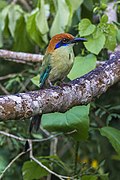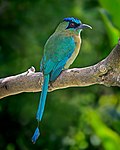Superregnum: Eukaryota
Regnum: Animalia
Subregnum: Eumetazoa
Cladus: Bilateria
Cladus: Nephrozoa
Superphylum: Deuterostomia
Phylum: Chordata
Cladus: Craniata
Subphylum: Vertebrata
Infraphylum: Gnathostomata
Superclassis: Tetrapoda
Cladus: Reptiliomorpha
Cladus: Amniota
Classis: Reptilia
Cladus: Eureptilia
Cladus: Romeriida
Subclassis: Diapsida
Cladus: Sauria
Infraclassis: Archosauromorpha
Cladus: Crurotarsi
Divisio: Archosauria
Subsectio: Ornithodira
Subtaxon: Dinosauromorpha
Cladus: Dinosauria
Ordo: Saurischia
Cladus: Theropoda
Cladus: Neotheropoda
Infraclassis: Aves
Cladus: Euavialae
Cladus: Avebrevicauda
Cladus: Pygostylia
Cladus: Ornithothoraces
Cladus: Euornithes
Cladus: Ornithuromorpha
Cladus: Ornithurae
Cladus: Carinatae
Parvclassis: Neornithes
Cohors: Neognathae
Ordo: Coraciiformes
Familia: Momotidae
Genus: Momotus
Species: M. aequatorialis – M. bahamensis – M. coeruliceps – M. lessonii – M. mexicanus – M. momota – M. subrufescens
Name
Momotus Brisson, 1760
Typus
Ramphastos momota Linnaeus, 1766 = Momotus momota
Synonyms
Baryphonus Vieillot, 1816
Crybelus Cabanis & Heine, 1859
Momot Lacépède, 1801 [variation]
Momota [variation]
Motmotus [variation]
References
Primary references
Brisson, M.J. 1760. Ornithologie ou méthode contenant la division des oiseaux en ordres, sections, genres, especes & leurs variétés. A laquelle on a joint une description exacte de chaque espece, avec les citations des auteurs qui en ont traité, les noms qu'ils leur ont donnés, ceux que leur ont donnés les différentes nations, & les noms vulgaires. Ouvrage enrichi de figures en taille-douce. Tome I. - pp. j-xxiv [= 1-24], 1-526, j-lxxiij [= 1-73], Pl. I-XXXVII [= 1-37]. Paris. (Bauche). Original description p.44 BHL Reference page. Pl.I fig.14 BHL Tome 4 p.465 BHL Pl.XXXV fig.3 BHL
References
Stiles, F. G. 2009. A review of the genus Momotus (Coraciiformes: Momotidae) in northern South America and adjacent areas. Ornitología Colombiana 8: 29–75. Full article (PDF).Reference page.
Momotus is a small genus of the motmots, a family of near passerine birds found in forest and woodland of the Neotropics. They have a colourful plumage, which is green on the back becoming blue on the flight feathers and the long tails. The barbs near the ends of the two longest central tail feathers fall off, leaving a length of bare shaft so that tails appear racket-shaped.
Momotus species, like other motmots, eat small prey such as insects and lizards, and will also take fruit. They nest in tunnels in banks, laying about four white eggs.
The genus Momotus was introduced by the French zoologist Mathurin Jacques Brisson in 1760 with the Amazonian motmot (Momotus momota) as the type species.[1][2]
Species
The species complex, the blue-crowned motmot (Momotus momota), has been split into several species.[3][4] The genus now contains seven species:[3]
| Image | Scientific name | Common Name | Distribution |
|---|---|---|---|
 |
Momotus mexicanus | Russet-crowned motmot | Guatemala and Mexico |
 |
Momotus momota | Amazonian motmot | eastern Venezuela to north-eastern Argentina |
 |
Momotus coeruliceps | Blue-capped motmot | eastern Mexico |
 |
Momotus aequatorialis | Andean motmot | northern Colombia to western Bolivia |
 |
Momotus bahamensis | Trinidad motmot | Trinidad and Tobago |
 |
Momotus lessonii | Lesson's motmot | southern Mexico to western Panama |
 |
Momotus subrufescens | Whooping motmot | southern Panama to northwestern Peru |
References
Brisson, Mathurin Jacques (1760). Ornithologie, ou, Méthode Contenant la Division des Oiseaux en Ordres, Sections, Genres, Especes & leurs Variétés (in French and Latin). Paris: Jean-Baptiste Bauche. Vol. 1, p. 44, Vol. 4, p. 465.
Peters, James Lee, ed. (1945). Check-list of Birds of the World. Volume 5. Cambridge, Massachusetts: Harvard University Press. p. 225.
Gill, Frank; Donsker, David, eds. (2019). "Todies, motmots, bee-eaters, hoopoes, wood hoopoes, hornbills". World Bird List Version 9.1. International Ornithologists' Union. Retrieved 3 April 2019.
Stiles, F.G. (2009). "A review of the genus Momotus (Coraciiformes: Momotidae) in northern South America and adjacent areas". Ornitología Colombiana. 8: 29–75.
Further reading
Birds of Venezuela by Hilty, ISBN 0-7136-6418-5
A guide to the birds of Costa Rica by Stiles and Skutch ISBN 0-8014-9600-4
Retrieved from "http://en.wikipedia.org/"
All text is available under the terms of the GNU Free Documentation License

